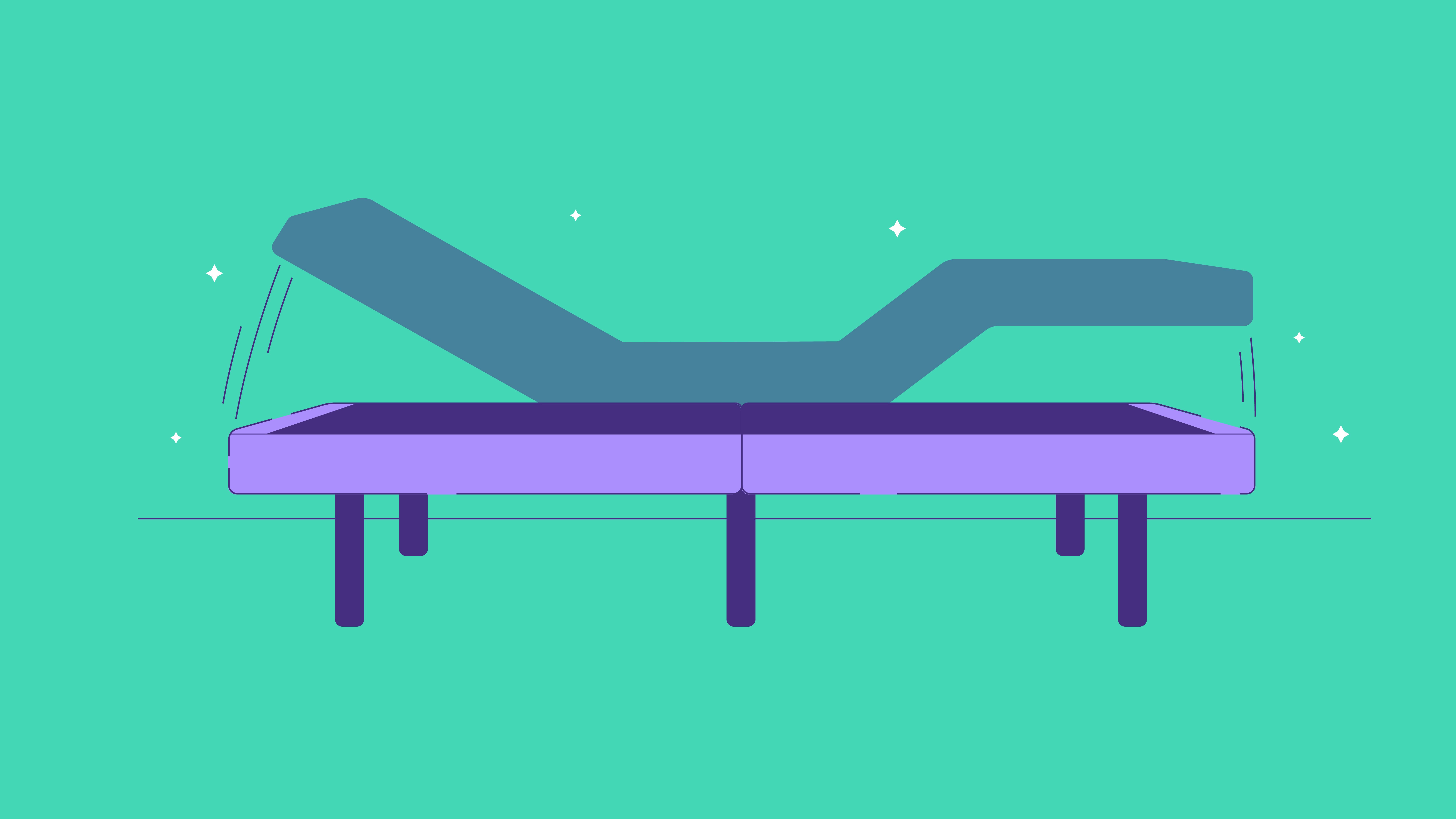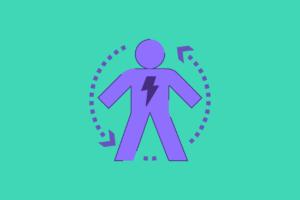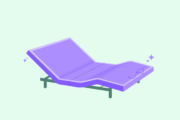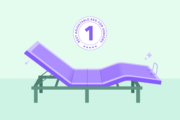
How to Set an Adjustable Bed to Zero Gravity Sleeping Position (And the Benefits)

- Understanding the basic mechanics of an adjustable bed, including its sleep surface, joints, and electric motors, helps users make the most of its features and functionalities.
- The convenience of using a remote control to adjust various sections of an adjustable bed makes it easy to find the most comfortable sleeping position, especially for individuals with specific health conditions or mobility issues.
- Selecting the right type of mattress for an adjustable bed, such as memory foam, latex, or hybrid mattresses, is crucial to ensure flexibility, durability, and optimal support while preventing damage to the mattress or the adjustable bed frame.
While you may not automatically associate astronauts with mattresses, the two are in fact linked. Not only did NASA bring us the incredibly-popular memory foam mattress in the 1970s, and gel foam mattresses in the 2010s, but they have also come up with what may very well be the ideal sleep position; also known as the zero gravity sleeping position.
Exciting name, isn’t it? Although you won’t actually float, this is a setting for your adjustable bed meant to alleviate pressure on the body. This “weightless” position will help to relieve pain, expand deep sleep, and help with overall health.
In this post, we review not only what “0-gravity” is, but discuss how to achieve this out-of-this-world sleep position with your adjustable bed frame, and take advantage of all of its benefits.
What Is Zero Gravity?
The zero-gravity position was calculated by NASA years ago when researchers were exploring ways to alleviate pressure on astronauts’ bodies during takeoff. However, once adjustable bed frames became popular, doctors and sleep experts began looking at the pressure-relieving benefits of sleeping in this position.
In the zero-gravity position, your torso and legs are both slightly elevated. Your knees will be slightly bent and kept level with your chest. Your head will also be raised slightly above your heart. This will result in your body appearing like a small “V” as your weight is evenly distributed.
Body weight is evenly distributed and the spine remains neutral when sleeping in zero gravity, allowing for enhanced relaxation and as a result, deeper sleep. While anybody can benefit from sleeping in this position, researchers have found snorers, as well as those with lower back pains, physically-demanding lifestyles, and sleep disorders see the most improvement in their shut-eye after transitioning to sleeping in the zero gravity sleeping position.
Adjusting to the Zero-Gravity Position
Some adjustable beds have a “Zero-G” preset, allowing you to adjust your bed to zero gravity at a click of a button. However, even if your bed doesn’t have a preset, it is still possible to adjust to “zero-g” and program the position for later—many electric bed frames allow you to save one or two positions so you can easily find the most comfortable angles for sleep again later.
In the next sections, we explain how to set your bed to the perfect zero gravity position.
Beds With a Zero-G Preset
If your adjustable bed already has a zero-gravity preset, you can shift to this position with the push of a button. Many adjustable bed frames pair with wireless remotes, or they’re Bluetooth-compatible. You can tell if your bed has one of these presets by looking for a Zero-G button on the base’s corresponding remote.
Beds Without a Zero-Gravity Preset
Some adjustable bed models, especially older ones, may not have a zero-gravity preset. In this case, you can simply manually set it to zero gravity yourself. The exact recommendations from NASA are 128° (+/-7°) between the torso and thigh, and 133° (+/-8°) between the hamstrings and calf. While this may sound complicated, in reality, setting your bed to zero gravity is very simple.
To set your adjustable bed to zero gravity, lift your upper body so it’s at a 120-degree angle with your thighs. Angle your knees so that they remain slightly bent while remaining above heart level. This in turn will reduce pressure on your neck, back, shoulders, and legs. Once you’re in this position, you’ve officially achieved zero gravity—congrats!
Programming the Zero-Gravity Position in Your Base
After you’ve adjusted your bed to the perfect zero-gravity position, check the remote for a save button. As we mentioned earlier, many bed bases come with programmable presets so you can save your favorite positions. If you are unable to find one, reach out to the manufacturer to ask if the bed has this capability..
Benefits of the Zero-Gravity Sleep Position
There are many benefits of sleeping on a zero-gravity adjustable bed, including better breathing and increased circulation. It can also alleviate some sleep problems such as snoring by allowing for better airflow. Below, we review some of the benefits of sleeping in a zero-gravity position and how they can improve sleep.
Better Breathing and Reduced Snoring
 The zero-gravity sleep position relieves pressure on your lungs and makes it easier to breathe. Not only is this helpful for those who snore or have sleep apnea, but it’s also great for those with asthma and allergies. Your head is slightly elevated when resting in the zero-gravity position, meaning your airways can remain open and allow for easier breathing; preventing the airways from narrowing results in a lesser chance of snoring.
The zero-gravity sleep position relieves pressure on your lungs and makes it easier to breathe. Not only is this helpful for those who snore or have sleep apnea, but it’s also great for those with asthma and allergies. Your head is slightly elevated when resting in the zero-gravity position, meaning your airways can remain open and allow for easier breathing; preventing the airways from narrowing results in a lesser chance of snoring.
Fewer Neck and Back Pains
 The spine is naturally shaped like an “S,” so sleeping with your back completely straight creates pressure in the spinal column. Zero gravity keeps your weight evenly distributed to avoid stress on your spinal column and maintain comfortable alignment.
The spine is naturally shaped like an “S,” so sleeping with your back completely straight creates pressure in the spinal column. Zero gravity keeps your weight evenly distributed to avoid stress on your spinal column and maintain comfortable alignment.
Sleeping in good posture can relieve neck and lower back pain significantly and give you a more peaceful night’s rest. This can be especially helpful for older individuals seeking an adjustable bed for seniors.
Improved Heart Health
 Zero gravity takes the pressure off of your muscles, including your heart, by evenly distributing your body weight. Easing pressure off of the heart muscle promotes blood flow and allows for increased circulation. As a result, zero gravity is a wonderful position for those with cardiovascular conditions, or just anybody looking to improve their heart health.
Zero gravity takes the pressure off of your muscles, including your heart, by evenly distributing your body weight. Easing pressure off of the heart muscle promotes blood flow and allows for increased circulation. As a result, zero gravity is a wonderful position for those with cardiovascular conditions, or just anybody looking to improve their heart health.
Heartburn Relief and Better Digestion
 It can be difficult to digest food when laying on your back on a flat surface. In this position, bile can more easily spill over from your stomach to your throat and cause heartburn.
It can be difficult to digest food when laying on your back on a flat surface. In this position, bile can more easily spill over from your stomach to your throat and cause heartburn.
Health professionals recommend sleeping with your upper body elevated when suffering from acid reflux and other digestive discomforts because sitting upright makes it more difficult for stomach acid to rise. With the contents of your stomach settled, you will be able to enjoy better digestion and heartburn-free sleep.
Superior Sleep Quality
 Zero gravity comes with many benefits, but the largest overall may simply be better quality sleep. Its increased comfort and weightless feeling, as well as relief of pressure points, facilitates a night of higher quality sleep.
Zero gravity comes with many benefits, but the largest overall may simply be better quality sleep. Its increased comfort and weightless feeling, as well as relief of pressure points, facilitates a night of higher quality sleep.
With a greater ability to sink into “deep” and REM sleep, the body is better able to restore itself. REM sleep gives the body a chance to restore its cells and muscles. Snorers will also achieve more REM sleep in zero gravity due to alleviate snoring.
How to Sleep on an Adjustable Bed
The zero-gravity position is considered to be most enjoyable for back sleepers. That said, side sleepers can still reap the benefits of this sleep position, as well. Keep in mind, zero gravity just might not feel as comfortable or as weightless for side sleepers as it does for back sleepers.
When adjusting to zero gravity, side sleepers may want to spend some extra time playing with the angle of their head and feet to find their most ideal position. Whether you’re a side or back sleeper, you should feel a sensation of weightlessness and full-body comfort when resting in the zero-gravity position correctly.
Please note, sleeping on your stomach in zero gravity is highly unrecommended. Stomach sleeping in zero gravity contorts your spine backwards, causing pain and discomfort. The effects can be minimized with a firm mattress for stomach sleeping, but it’s still best to try a different sleep position.
Having the Best Mattress for an Adjustable Bed
The right mattresses for an adjustable bed can be neither too thick nor too thin, as they must be able to move with the base and feel comfortable at different angles. Foam mattresses, such as memory foam and latex mattresses, are common choices, though hybrid mattresses can also typically flex with the base.
If you have to buy a new mattress along with an adjustable bed, it can put quite the dent in the budget. To save significantly on a brand new mattress, we suggest taking advantage of the year’s big mattress sales as they roll out:
- Best MLK Day Mattress Sales
- Best Presidents Day Mattress Sales
- Best Memorial Day Mattress Sales
- Best 4th of July Mattress Sales
- Best Labor Day Mattress Sales
- Best Columbus Day Mattress Sales
- Best Black Friday Mattress Sales
- Best Cyber Monday Mattress Sales
FAQs
Why is it called “zero gravity” if I don’t float?
“Zero gravity” refers to the weightlessness you feel while laying down in the zero-gravity position. While you are not actually weightless, this sensation is caused by the support of the position distributing your weight evenly. You may feel a comfortable floating sensation as you sleep in the zero-gravity position—hence the name.
How does gravity negatively affect me?
Gravity creates pressure on your muscles and joints, gradually taking a toll on the body. When you lay down into bed, gravity pulls your body into the mattress. If your mattress presses against already-tender pressure points, or creates new pain points, you’ll want to switch your mattress.
However, even the most comfortable of mattresses can’t offset gravity as well as sleeping in Zero-G can. Adjustable beds set to zero-gravity work to counteract gravity’s constant force and relieve tension throughout the body.
Is it difficult to set an adjustable bed to zero gravity?
It’s easy to set a bed with an adjustable base to zero gravity, even if it does not have a zero-gravity preset. To start, elevate your chest and legs at the proper angles. You can do this by either using your bed’s Zero-G preset button, or by elevating both your chest and legs at a 120-degree position. Find the position that works best for you, and if possible, save it so you can go back zero-gravity whenever you desire.
Will my innerspring mattress work in the zero gravity position?
You can tell if your innerspring mattress will work in the zero-gravity position by looking at its age and quality of materials. Most newer innerspring mattresses are made with flexible pocketed coils to move with adjustable bed frames. Older innerspring mattresses, however, have less-advanced coil systems and are not as equipped for adjustable bed use or the zero gravity position.
For more information, check out our guide on mattresses that work with adjustable beds.
Can zero gravity reduce swelling?
Elevating your legs promotes healthier circulation and reduces swelling. Zero gravity is a perfect position for those who have swollen legs or feet, such as pregnant women or those who work long shifts since the legs and feet are level with your chest. Sleepers with aches and pains require extra relief to enjoy a comfortable night’s rest, which zero gravity can provide by improving overall circulation.
Conclusion
With its superior comfort, it’s easy to see why sleeping on an adjustable bed in zero gravity is becoming the preferred method of many. Not only does it provide pain relief by alleviating pressure points, but zero gravity also provides many other great health benefits—including reduced snoring, improved circulation, and better overall quality sleep, to name a few. If you currently have or are looking at acquiring an adjustable bed, try the zero-gravity position tonight to float peacefully to sleep.



